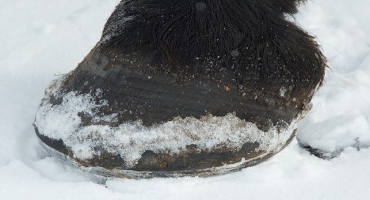Headlines across the nation are reporting freezing conditions followed by short respites of warm weather quickly chased away by arctic temperatures. Many horse paddocks are currently more suitable for a hockey game than turnout. Michigan State University Extension has some advice for horse owners challenged with icy conditions. If your horses are stabled indoors, you are wise to think twice before turning them out in icy conditions. While having four legs may give horses more balance than their two-legged owners, they can still slip and fall on an icy surface. Risks increase for younger, inexperienced horses and very active horses, as a playful miss-step on the ice could result in a serious injury.
Outdoor Housing
Experienced horses housed outdoors are likely to negotiate an icy paddock with caution and limit their activity to the necessities of eating and drinking. Consider moving feeders and waterers closer to shelters to reduce the time horses spend walking on ice. Plowing paddocks can help break up ice and produce a rougher surface to aid traction. In addition, removing large amounts of snow from high use areas will decrease water buildup once the paddocks thaw. Be sure to pick up manure piles in the paddock and shelter during the winter. Frozen manure is like small boulders, adding one more obstacle your horse must negotiate during the winter.
Traction in a paddock can also be improved by applying sand, wood ash, shavings and woodchips atop the icy surface. More unconventional toeholds include cat litter, poultry grit, and dirty bedding. Slightly wetting an icy surface before applying the gripping material will help it stick to the ground. Any material you spread will wash away once it thaws. Pet friendly salt can also be used to melt ice in high traffic locations, as long as the temperature stays above 15 degrees Fahrenheit.
Don’t forget to clear your barn roads of snow for emergency vehicles. Salting your roads may also be an option to reduce ice; however, be cautious of salty runoff into your horse’s paddock when temperatures warm up.

Hoof Care
Most horses housed outdoors are barefoot, allowing for more traction in snow and ice when compared to their shod counterparts. Keeping your horse’s hooves trimmed during the winter will help reduce snow packing into their soles. Keep in mind that trimming the hooves too short in frozen conditions may lead to bruised feet. If snow does accumulate in the soles of the hooves, simply remove it with a hoof pick. If a horse has fallen on ice and is struggling to rise, fitting them in Easyboots (removable boots that go over their hooves) may provide enough traction to enable them to get back on their feet.
If you are riding a horse consistently outdoors in a snowy climate, discuss winter shoeing options with your farrier. The addition of winter studs or borium-tipped horseshoe nails will give a shod horse more foothold for winter riding. In addition, snow pads will reduce snowpack in the hooves.
Farm Safety
Put your safety first when handling horses during the winter. A horse that is accustomed to daily turnout may get “cabin fever” when cooped up in their stall. As always, practice safe horsemanship when performing daily chores including grooming, cleaning stalls, and feeding. An indoor arena that is safe for turnout may give your horse some much needed free exercise. Make sure that all obstacles and equipment are removed from the arena and that the horse can’t reach any mirrors or glass. If you don’t have access to an indoor arena, hand walk your horse through the barn alleyway and brush up on your showmanship skills.
Make sure that your own footwear will keep you on your feet rather than on your seat! Most riding boots are smooth soled making them extra slippery on ice. Removable ice traction cleats will help convert your riding boots to more ice worthy foot gear. Heavy snow boots with a deep tread can aid in traction as well as keep your feet warm during chores.
Winter Preparation
Preparing for icy conditions begins in the warm months. Make sure that water ways are fenced off from horses to ensure your horse doesn’t fall through a frozen pond. Build your winter paddocks and shelters in well drained areas. Make sure that your natural drainage flows away from paddocks, stables, and roadways. Areas prone to summer flooding are more likely to get icy in the winter. Use French drains, strategically placed ditches, and geotextile fabric combined with footing materials in low lying or high traffic areas (like gates, walkways, and feeding areas) to keep your facility dry throughout the year. Check and clean gutters and drainage ditches periodically and ensure building downspouts are deflected away from walkways to prevent ice buildup.
Conclusion
Unlike other seasonal recreational equipment, horses need year-round care in all types of weather. Your equestrian activities don’t need to come to a halt in the winter. In fact, with proper planning and due diligence, working with our horses and making sure they are safe and comfortable in the winter months can help reduce our own cabin fever!
Source: msu.edu